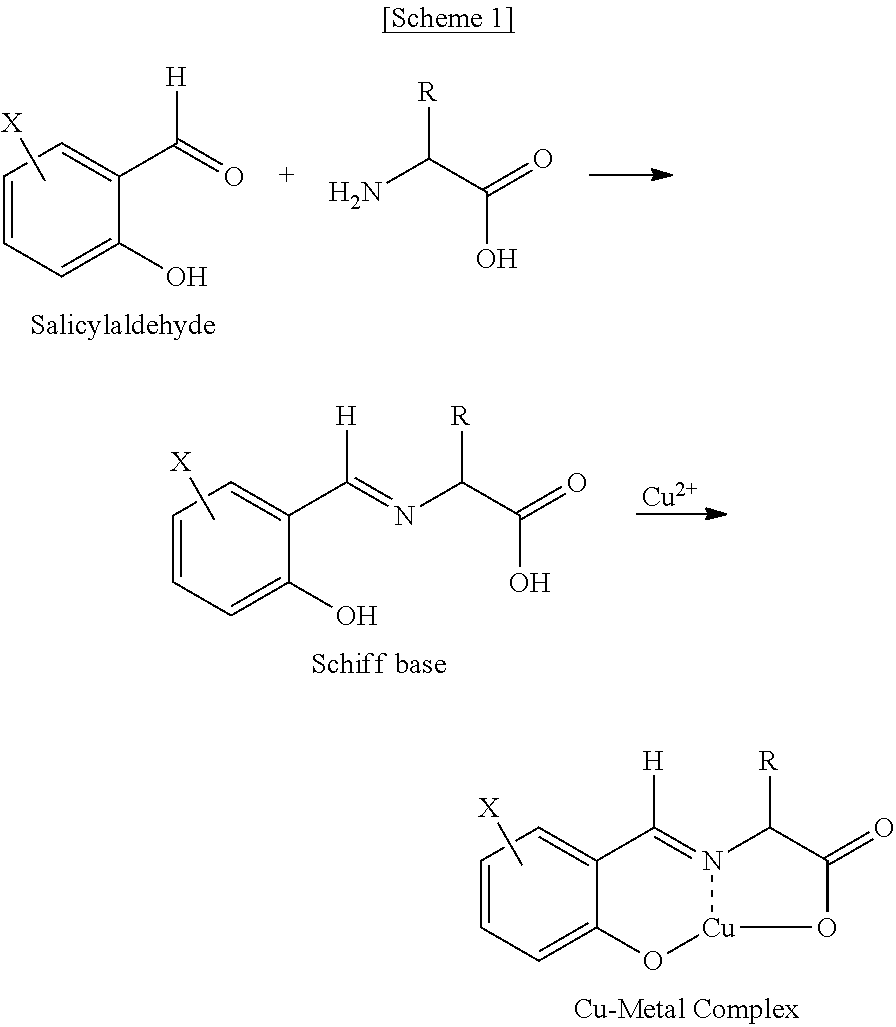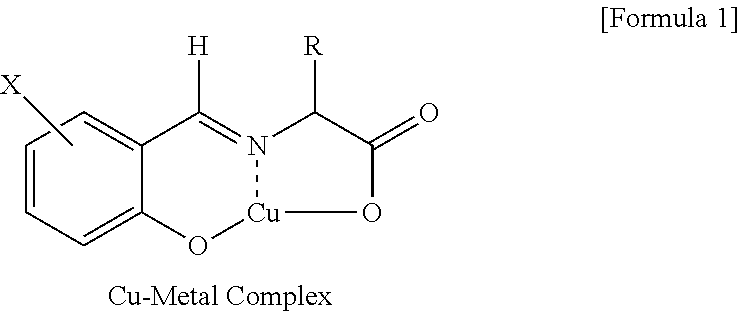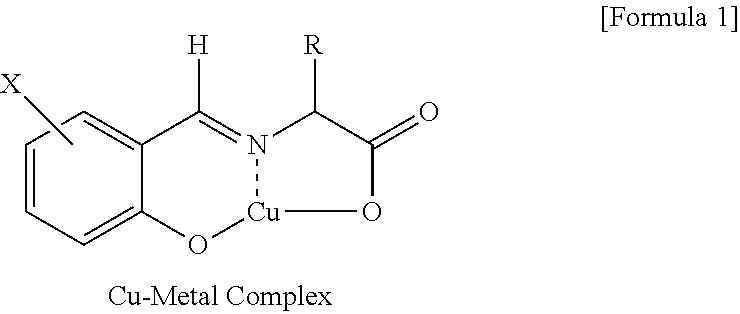Process for the racemization of α-amino acids
a technology of -amino acids and -amino acids, which is applied in the direction of organic compounds/hydrides/coordination complexes, physical/chemical process catalysts, peptides, etc., can solve the problems of complex process for its use and recovery, low yield of -amino acids, bitter smell and toxicity of solvents, etc., and achieves less decomposition of -amino acids , the effect of high yield
- Summary
- Abstract
- Description
- Claims
- Application Information
AI Technical Summary
Benefits of technology
Problems solved by technology
Method used
Image
Examples
example 1
Racemization of L-phenylalanine
[0057](1) Preparation of an Organic Layer Containing Copper Metal Complex
[0058]In dichloromethane 120 mL, 5-nitrosalicylaldehyde (10.0 g, 59.8 mmol) and Aliquat 336 (33.9 g, 83.9 mmol) were dissolved to give an organic phase. In distilled water 100 ml, racemic phenylalanine (19.8 g, 119.9 mmol), sodium hydroxide (5.75 g, 144 mmol) and copper chloride (CuCl2) (1.6 g, 11.9 mmol) were dissolved to give an aqueous phase. The organic phase and the aqueous phase were mixed, the resultant two-phase mixture was vigorously stirred for 2 hours, followed by a phase separation to give an organic layer containing copper metal complex.
[0059](2) Racemization
[0060]In distilled water 500 ml, L-phenylalanine (98.8 g, 598 mmol) and sodium hydroxide (28.7 g, 718 mmol) were dissolved to give an aqueous phase, to which the organic layer obtained in the above step 1) was introduced. The resultant two-phase mixture was stirred at 25° C. for 12 hours, followed by a phase separ...
example 6
Racemization of L-phenylalanine
[0069]1) Preparation of an Organic Layer Containing Copper Metal Complex
[0070]In dichloromethane 70 mL, 5-nitrosalicylaldehyde (5.0 g) and Aliquat 336 (17 g) were dissolved to give an organic phase. In distilled water 50 ml, L-phenylalanine (10 g), sodium hydroxide (2.9 g) and copper chloride (CuCl2) (0.8 g) were dissolved to give an aqueous phase. The organic phase and the aqueous phase were mixed and the resultant two-phase mixture was vigorously stirred for 2 hours, followed by a phase separation to obtain an organic layer containing copper metal complex.
[0071]2) Racemization
[0072]In distilled water 260 ml, L-phenylalanine (50 g) and sodium hydroxide (14.5 g) were dissolved to give an aqueous phase, to which the organic layer obtained in the above step 1) was introduced. The resultant two-phase mixture was stirred at 25° C. for 12 hours, followed by a phase separation to give an aqueous layer. The aqueous layer was analyzed with a chiral column (Chi...
example 7
Racemization of L-phenylalanine
[0073]1) Preparation of an Organic Layer Containing Copper Metal Complex
[0074]In dichloromethane 115 mL, salicylaldehyde (7.3 g) and Aliquat 336 (33.6 g) were dissolved to give an organic phase. In distilled water 100 ml, racemic phenylalanine (19.8 g), sodium hydroxide (5.75 g) and copper sulfate (CuSO4) (1.9 g) were dissolved to give an aqueous phase. The organic phase and the aqueous phase were mixed and the resultant two-phase mixture was vigorously stirred for 2.5 hours, followed by a phase separation to obtain an organic layer containing copper metal complex.
[0075]2) Racemization
[0076]In distilled water 500 ml, L-phenylalanine (98.8 g) and sodium hydroxide (28.7 g) were dissolved to prepare an aqueous phase, to which the organic phase obtained in the above step 1) was added. The resultant two-phase mixture was stirred for 13 hours at 25° C., followed by phase separation to give an aqueous layer. The aqueous layer was analyzed by a chiral column (...
PUM
| Property | Measurement | Unit |
|---|---|---|
| temperature | aaaaa | aaaaa |
| temperature | aaaaa | aaaaa |
| temperature | aaaaa | aaaaa |
Abstract
Description
Claims
Application Information
 Login to View More
Login to View More - R&D
- Intellectual Property
- Life Sciences
- Materials
- Tech Scout
- Unparalleled Data Quality
- Higher Quality Content
- 60% Fewer Hallucinations
Browse by: Latest US Patents, China's latest patents, Technical Efficacy Thesaurus, Application Domain, Technology Topic, Popular Technical Reports.
© 2025 PatSnap. All rights reserved.Legal|Privacy policy|Modern Slavery Act Transparency Statement|Sitemap|About US| Contact US: help@patsnap.com



